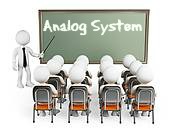
Analog System. Radios transmit analog signal over-the-air. Our original voice, which is in analog format, is modulated and amplified inside the radio before transmitted. There is no additional computer processing (i.e. digitization) inside analog radio. Analog radio system continuously transmits radio waves that are usually modulated by a voice.
One example of analog radios is FM radio broadcasting services. Another is AM aircraft radios used to communicate between control towers and air traffic controllers. A walkie-talkie, like the Family Radio Service available, to the public is another example of analog radio.
Category: LEARNING CENTRE
Tags: analog, analog system